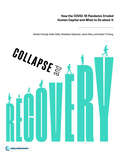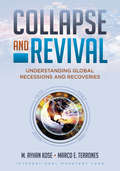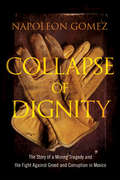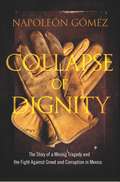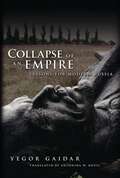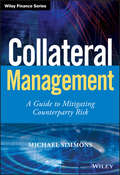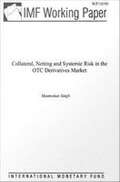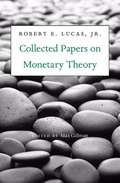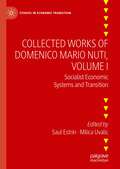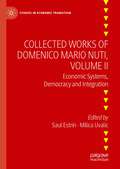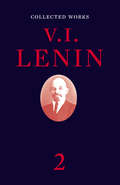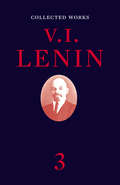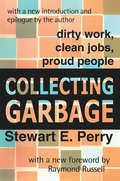- Table View
- List View
Collage.com: Scaling a Distributed Organization
by Shikhar Ghosh Christopher StantonKevin Borders and Joe Golden, co-founders and co-CEOs of Collage.com, must decide how to grow their custom photo-products startup in the face of fierce competition. From 2011 through 2016, the business evolved from a hobby to a startup with $22 million in revenue and 45 employees, all of whom worked remotely from home. Customer acquisition was becoming more difficult and repeat purchase rates lagged behind Shutterfly, the industry leader. New hires would help to integrate new products and grow marketing efforts, but several experienced team members wondered whether virtual collaboration could continue to work with an influx of new people.
Collage.com: Scaling a Distributed Organization (Abridged)
by Shikhar Ghosh William R. Kerr Christopher Stanton Sarah Gulick James PalanoCase
Collapse and Recovery: How the COVID-19 Pandemic Eroded Human Capital and What to Do about It
by Silva Norbert Schady Alaka Holla Shwetlena SabarwalWorldwide, the COVID-19 pandemic has been an enormous shock to mortality, economies, and daily life. But what has received insufficient attention is the impact of the pandemic on the accumulation of human capital—the health, education, and skills—of young people. How large was the setback, and how far are we still from a recovery? Collapse and Recovery estimates the impacts of the pandemic on the human capital of young children, school-age children, and youth and discusses the urgent actions needed to reverse the damage. It shows that there was a collapse of human capital and that, unless that collapse is remedied, it is a time bomb for countries. Specifically, the report documents alarming declines in cognitive and social-emotional development among young children, which could translate into a 25 percent reduction in their earnings as adults. It finds that 1 billion children in low- and middle-income countries missed at least one year of in-person schooling. And despite enormous efforts in remote learning, children did not learn during the unprecedentedly long school closures, which could reduce future lifetime earnings around the world by US$21 trillion. The report quantifies the dramatic drops in employment and skills among youth that resulted from the pandemic as well as the substantial increase in the number of youth neither employed nor enrolled in education or training. In all of these age groups, the impacts of the pandemic were consistently worse for children from poorer backgrounds. These losses call for immediate action. The good news is that evidence-based policies can recover these losses. Collapse and Recovery reviews governments’ responses to the pandemic, assessing why there was a collapse in human capital accumulation, what was missing in the policy architecture to protect human capital during the crisis, and how governments can better prepare to withstand future shocks. It offers concrete policy recommendations to recover losses in human capital—programs that will end up paying for themselves in the long term. To better prepare for future shocks such as climate change and wars, the report emphasizes the need for solutions that bring health, education, and social protection programs together in an integrated human development system. If countries fail to act, the losses in human capital documented in this report will become permanent and last for multiple generations. The time to act is now.
Collapse and Revival
by M. Ayhan Kose Marco E. TerronesAs the debates about the recent global recession and the subsequent recovery have clearly shown, our understanding of these questions has been very limited. In this book, we undertake a systematic analysis of global recessions and recoveries to address these questions. Specifically, we define the terms of global recessions and recoveries; document their main features; describe the events that take place around these episodes; put the latest global recession and ongoing recovery in perspective; and analyze the interactions between fluctuations in the global growth and national growth over the different phases of the global cycle.
Collapse and Survival: Industry Strategies in a Changing World (Routledge Revivals)
by Robert Ballance Stuart SinclairFirst published in 1983, Collapse and Survival was written as an examination of the position of industry worldwide at the time of publication. The book looks at the post-war growth of output and the policies adopted in advanced countries, socialist countries, and LDCs to bolster and shape this growth. It explores in detail the experience of firms across several of the industries at the forefront of the changes in world industry since 1945, including automobiles, steel, consumer electronics, advanced electronics, and oil refining. Particular attention is paid to the influence that the majority of countries, public agencies, lobbyists and other interests have in shaping the business environment in which firms operate. This analysis provides the basis for a description of the business strategies open to firms in each of these key industries. Collapse and Survival will appeal to those with an interest in the history of industrial and development economics, and international business and economics.
Collapse in Asia--1997-98
by George C. Lodge Anthony St. GeorgeDiscusses the Asian crisis and economists' opinions and solutions.
Collapse of Dignity: The Story of a Mining Tragedy and the Fight Against Greed and Corruption in Mexico
by Napoleon Gomez#4 Book on The New York Times Monthly Business Bestseller List #9 Book on The New York Times Monthly Political Bestseller List #9 Book on The New York Times Weekly Nonfiction Bestseller List USA Today Bestseller In the early morning hours of February 19, 2006, a sudden blast shook a coal mine in northern Mexico, trapping sixty-five workers in a subterranean tunnel. Napoleón Gómez, head of the fiercely independent union that represented the workers, was appalled by what he found at the scene: labor department inspectors and the company operating the mine had ignored the egregiously hazardous state of the work site and were failing miserably at a rescue effort. Rather than focusing on saving lives, they were busy downplaying the company's role in the collapse and selling false hope to the families camped out at the mouth of the mine. Less than a week after the explosion, Mexico's labor secretary called off the rescue, leaving the lost men to their fates.The senseless tragedy-stemming directly from an insatiable hunger for profits-set off a massive confrontation between the National Miners' Union and the transnational corporations that wield great power in the country's government. Over seven tumultuous years, Gómez waged a battle against Mexico's corrupt politicians and voraciously greedy businessmen, insisting that the mine blast was an "industrial homicide" and that those responsible must be held accountable for it.Told with candor and passion, Collapse of Dignity is Gómez's account of the union's fight, mounted in the face of traitors, armed aggression, death threats, and a political alliance extending all the way up to the presidential residence at Los Pinos. As he fends off absurdly complex legal charges, organizes the resistance from exile in Canada, and uncovers an anti-union conspiracy stretching back to years before the explosion, he only becomes more committed to fighting for the rights of Los Mineros-and by extension the workers of every country.Gómez's story is one of outrage, but also one of hope. Though Collapse of Dignity lays bare sickening injustice and inexcusable aggression against the Mexican working class, it is at its core a fervent call for a global workers' movement that will represent the fundamental rights of every person who works for a living.
Collapse of Dignity: The Story of a Mining Tragedy and the Fight Against Greed and Corruption in Mexico
by Napoleon Gomez UrrutiaIn this book, Napoleon Gomez Urrutia tells the story of the Mexican government's war against the National Union of Mine, Metal, and Steelworkers of the Mexican Republic (Los Mineros) and of the union's eight-year battle of resistance.
Collapse of an Empire: Lessons for Modern Russia
by Yegor GaidarThe Soviet Union was an empire in many senses of the word—a vast mix of far-flung regions and accidental citizens by way of conquest or annexation. <P><P>Typical of such empires, it was built on shaky foundations. That instability made its demise inevitable, asserts Yegor Gaidar, former prime minister of Russia and architect of the "shock therapy" economic reforms of the 1990s. Yet a growing desire to return to the glory days of empire is pushing today's Russia backward into many of the same traps that made the Soviet Union untenable. In this important new book, Gaidar clearly illustrates why Russian nostalgia for empire is dangerous and ill-fated: "Dreams of returning to another era are illusory. Attempts to do so will lead to defeat." Gaidar uses world history, the Soviet experience, and economic analysis to demonstrate why swimming against this tide of history would be a huge mistake. The USSR sowed the seeds of its own economic destruction, and Gaidar worries that Russia is repeating some of those mistakes. Once again, for example, the nation is putting too many eggs into one basket, leaving the nation vulnerable to fluctuations in the energy market. The Soviets had used revenues from energy sales to prop up struggling sectors such as agriculture, which was so thoroughly ravaged by hyperindustrialization that the Soviet Union became a net importer of food. When oil prices dropped in the 1980s, that revenue stream diminished, and dependent sectors suffered heavily. Although strategies requiring austerity or sacrifice can be politically difficult, Russia needs to prepare for such downturns and restrain spending during prosperous times. Collapse of an Empire shows why it is imperative to fix the roof before it starts to rain, and why sometimes the past should be left in the past.
Collateral Frameworks
by Kjell G. NyborgCentral bank collateral frameworks are an often overlooked feature of monetary policy that play a key role in the monetary and financial system. Readers will discover how central banks conduct and implement monetary policy beyond merely setting interest rates, and develop their understanding as to how collateral policies may affect financial markets, financial stability, and the real economy. This book studies the collateral framework in the euro area in detail, and levers this analysis to provide an account of the euro crisis from the perspective of collateral policy. Readers gain access to a wealth of institutional and economic data and information with a level of density and accessibility unavailable elsewhere. This book, the first of its kind, is a valuable read for academic monetary and financial economists, those working in banking and policy-making financial institutions, and anyone who wishes to learn more about the role of central banks in society.
Collateral Management: A Guide to Mitigating Counterparty Risk (Wiley Finance)
by Michael SimmonsInsight into collateral management and its increasing relevance in modern banking In the wake of recent financial crises, firms of all sizes have adjusted their policies to incorporate more frequent instances of collateral management. Collateral Management: A Guide to Mitigating Counterparty Risk explains the connection between the need for collateral management in order to alleviate counterparty risk and the actions that firms must take to achieve it. Targeted at middle and back office managers seeking a hands-on explanation of the specifics of collateral management, this book offers a thorough treatment of the subject and attends to details such as internal record management, daily procedures used in making and receiving collateral calls, and settlement-related issues that affect the movements of cash and securities collateral. An expert in financial topics ranging from trade lifecycle to operational risk, author Michael Simmons offers readers insight into a field that, so far, is struggling to produce enough expertise to meet its high demand. Presents hands-on advice and examples from a bestselling, internationally renowned author who introduces his third book on operations and operations-related activities Explains the relationship between collateral management and preventing institutional defaults, such as the recent Lehman Brothers downfall Since 2008, firms have recognized and embraced the importance of collateral management, but this book will provide practitioners with a deeper understanding and appreciation of its relevance.
Collateral, Netting and Systemic Risk in the OTC Derivatives Market
by Manmohan SinghA report from the International Monetary Fund.
Collateralized Loan Obligations and the Bistro Trust
by Kenneth A. Froot Ivan FarmanThis case examines a large bank trying to protect itself from the risks and capital requirement created by its loan portfolio. Considers a variety of ways available to the firm to offload the risks.
Collected Papers James Meade V1 (Routledge Library Editions Ser.)
by Susan HowsonFirst Published in 2004. Routledge is an imprint of Taylor & Francis, an informa company.
Collected Papers James Meade V2 (Routledge Library Editions Ser.)
by Susan HowsonFirst Published in 2004. Routledge is an imprint of Taylor & Francis, an informa company.
Collected Papers James Meade V3 (Routledge Library Editions Ser.)
by Susan HowsonFirst Published in 2004. This is Volume III of four on the collected papers of James Meade and looks at International Economics. James Meade was Professor of Commerce London School of Economics from February 1948.
Collected Papers James Meade V4 (Routledge Library Editions Ser.)
by Susan HowsonFirst Published in 2004. Routledge is an imprint of Taylor & Francis, an informa company.
Collected Papers on Monetary Theory
by Robert E. Lucas Jr.Robert Lucas is one of the outstanding monetary theorists of the past hundred years. Along with Knut Wicksell, Irving Fisher, John Maynard Keynes, James Tobin, and Milton Friedman (his teacher), Lucas revolutionized our understanding of how money interacts with the real economy of production, consumption, and exchange. Lucas's contributions are both methodological and substantive. Methodologically, he developed dynamic, stochastic, general equilibrium models to analyze economic decision-makers operating through time in a complex, probabilistic environment. Substantively, he incorporated the quantity theory of money into these models and derived its implications for money growth, inflation, and interest rates in the long run. He also showed the different effects of anticipated and unanticipated changes in the stock of money on economic fluctuations, and helped to demonstrate that there was not a long-run trade-off between unemployment and inflation (the Phillips curve) that policy-makers could exploit. The twenty-one papers collected in this volume fall primarily into three categories: core monetary theory and public finance, asset pricing, and the real effects of monetary instability. Published between 1972 and 2007, they will inspire students and researchers who want to study the work of a master of economic modeling and to advance economics as a pure and applied science.
Collected Works of Domenico Mario Nuti, Volume I: Socialist Economic Systems and Transition (Studies in Economic Transition)
by Saul Estrin Milica UvalicThis book, the first of two volumes, brings together the work of Domenico Mario Nuti to highlight his significant and varied contribution to economics. Bringing together works from across Nuti’s career, his distinctive intellectual framework is exemplified in relation to discussions on the drivers of economic growth and development, the most efficient economic system, the organisation of firms, and how economies should be managed. This volume gives particular attention to socialist economic systems, and the transition of former socialist countries to market economies. This book, through the inclusion of an introduction, aims to contextualise his ideas and illustrate their continued relevance. It will be of wide interest to students and researchers.
Collected Works of Domenico Mario Nuti, Volume II: Economic Systems, Democracy and Integration (Studies in Economic Transition)
by Saul Estrin Milica UvalicThis book, the second of two volumes, brings together the work of Domenico Mario Nuti to highlight his significant and varied contribution to economics. Bringing together works from across Nuti’s career, his distinctive intellectual framework is exemplified in relation to discussions on the drivers of economic growth and development, the most efficient economic system, the organisation of firms, and how economies should be managed. This volume gives particular attention to Nuti’s views about how economic systems evolve, about the possibilities for various forms of economic democracy; and his analysis of East-West integration and globalization. The volume also contains a bibliography of his works.
Collected Works, Volume 1
by V. I. LeninAmong the most influential political and social forces of the twentieth century, modern communism rests firmly on philosophical, political, and economic underpinnings developed by Vladimir Ilyich Ulyanov, later known as Lenin. For anyone who seeks to understand the twentieth century, capitalism, the Russian Revolution, and the role of Communism in the tumultuous political and social movements that have shaped the modern world, the works of Lenin offer unparalleled insight and understanding. Taken together, they represent a balanced cross-section of his revolutionary theories of history, politics, and economics; his tactics for securing and retaining power; and his vision of a new social and economic order.This first volume contains four works (“New Economic Developments in Peasant Life,” “On the So-Called Market Question,” “What the ‘Friends of the People’ Are and How They Fight the Social- Democrats,” “The Economic Content of Narodism and the Criticism of It in Mr. Struve’s Book”) written by Lenin in 1893–1894, at the outset of his revolutionary activity, during the first years of the struggle to establish a workers’ revolutionary party in Russia.
Collected Works, Volume 2
by V. I. LeninRe-launch of the Collected Works of the legendary revolutionary in paperbackAmong the most influential political and social forces of the twentieth century, modern communism rests firmly on philosophical, political, and economic underpinnings developed by Vladimir Ilyich Ulyanov, later known as Lenin. For anyone who seeks to understand the twentieth century, capitalism, the Russian Revolution, and the role of Communism in the tumultuous political and social movements that have shaped the modern world, the works of Lenin offer unparalleled insight and understanding. Taken together, they represent a balanced cross-section of his revolutionary theories of history, politics, and economics; his tactics for securing and retaining power; and his vision of a new social and economic orderThis second volume contains Lenin’s works from 1895 to 1897. Included are Lenin’s early economic and political writings, as well as his prescriptions for the program and strategy of Russian Marxism.
Collected Works, Volume 3
by V. I. LeninRe-launch of the Collected Works of the legendary revolutionary in paperbackAmong the most influential political and social forces of the twentieth century, modern communism rests firmly on philosophical, political, and economic underpinnings developed by Vladimir Ilyich Ulyanov, later known as Lenin. For anyone who seeks to understand capitalism, the Russian Revolution, and the role of communism in the tumultuous political and social movements that have shaped the modern world, the works of Lenin offer unparalleled insight and understanding.
Collecting Compensation Data from Employers
by Panel On Measuring Collecting Pay Information from U.S. Employers by Gender Race National OriginU. S. agencies with responsibilities for enforcing equal employment opportunity laws have long relied on detailed information that is obtained from employers on employment in job groups by gender and race/ethnicity for identifying the possibility of discriminatory practices. The U. S. Equal Employment Opportunity Commission (EEOC), the Office of Federal Contract Compliance programs of the U. S. Department of Labor, and the Civil Rights Division of the U. S. Department of Justice have developed processes that use these employment data as well as other sources of information to target employers for further investigation and to perform statistical analysis that is used in enforcing the anti-discrimination laws. The limited data from employers do not include (with a few exceptions) the ongoing measurement of possible discrimination in compensation. The proposed Paycheck Fairness Act of 2009 would have required EEOC to issue regulations mandating that employers provide the EEOC with information on pay by the race, gender, and national origin of employees. The legislation was not enacted. If the legislation had become law, the EEOC would have been required to confront issues regarding currently available and potential data sources, methodological requirements, and appropriate statistical techniques for the measurement and collection of employer pay data. The panel concludes that the collection of earnings data would be a significant undertaking for the EEOC and that there might be an increased reporting burden on some employers. Currently, there is no clearly articulated vision of how the data on wages could be used in the conduct of the enforcement responsibilities of the relevant agencies. Collecting Compensation Data from Employers gives recommendations for targeting employers for investigation regarding their compliance with antidiscrimination laws.
Collecting Garbage: Dirty Work, Clean Jobs, Proud People
by Raymond Russell Stewart E. PerryFirst Published in 2017. Routledge is an imprint of Taylor & Francis, an Informa company.

